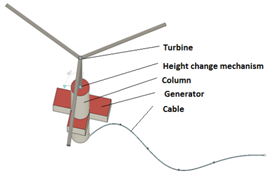
Fig. 1 Wave energy converter
Development of a wave energy converter
The world's population is growing [1] and it’s level of development is increasing. Therefore is observed an increase of energy consumption in total (TWh) [2] and per capita (kWh/year/capita) [3]. The production of energy (more correctly - converting) must compensate the increase of total energy consumption, so energy production should be increased. One of the renewable energy sources is the waves of oceans and seas. There is a world wave power estimate of 2.11 ± 0.05 TW [4]. Wave energy is free from CO2 emissions. In order to be able to use this environmentally friendly energy type in the economy, power plants (WEP) that convert wave energy into electricity are needed. Power plants consist of installations that perform functions for capturing and transforming wave energy (followed by wave energy converters WEC). World-wide work is taking place on WEC technology solutions [5]. There are a number of factors determining the effectiveness of WEP besides wave power potential and it’s transformation technology [6]. Wave power plants should consist of a set of n wave conversion equipment capable of transforming wave energy sufficiently efficiently. That is why:
1. A list of problems to be addressed has been drawn up [7]. 2. An analysis has been carried out [8]. 3. A sequence of problems to be resolved has been drawn up [9]. 4. An approach has been developed to address the challenges to be addressed [10].
We have come to the conclusion that a turbine with a vertical axle and adjustable spades could be possible and perspective wave energy converter (Fig. 1).